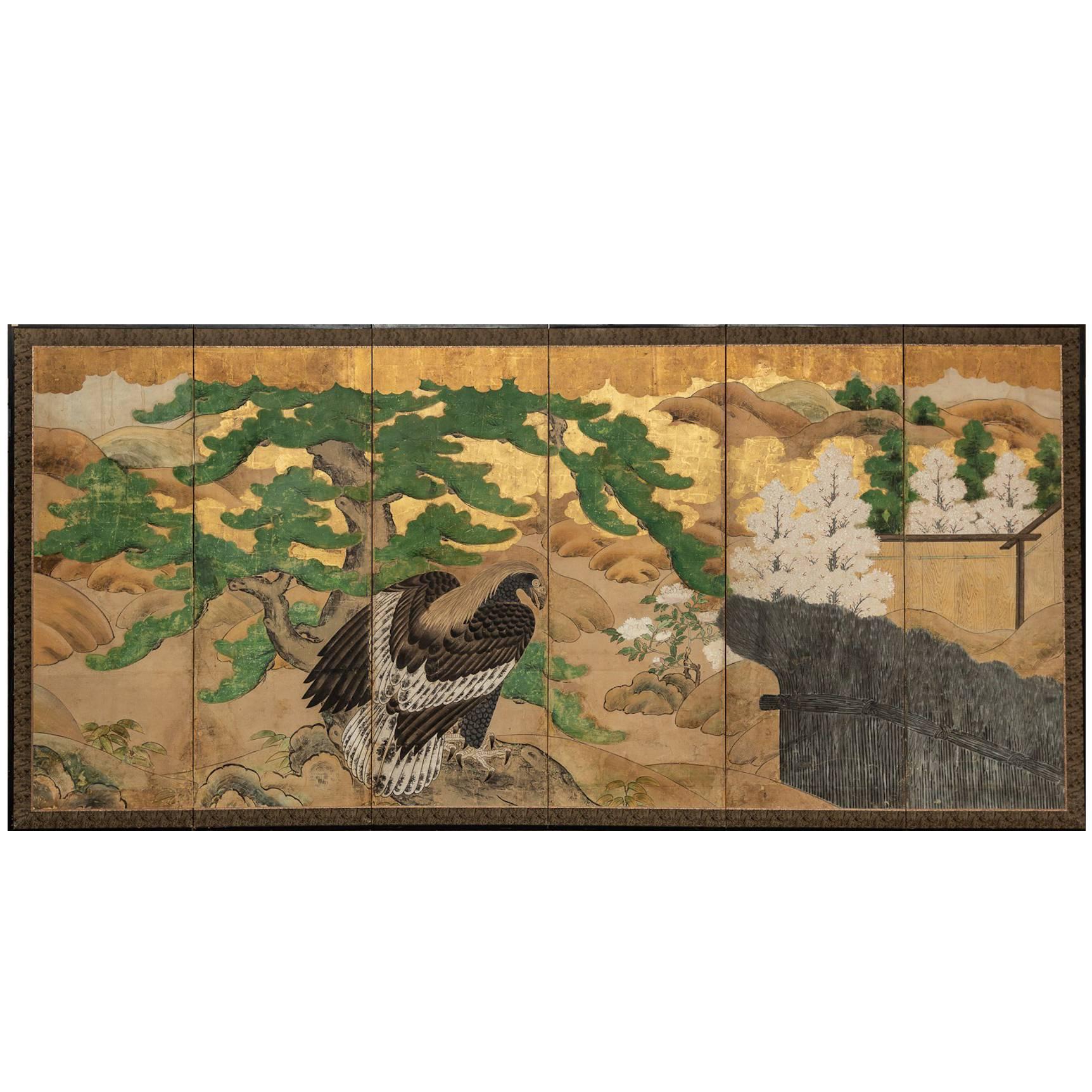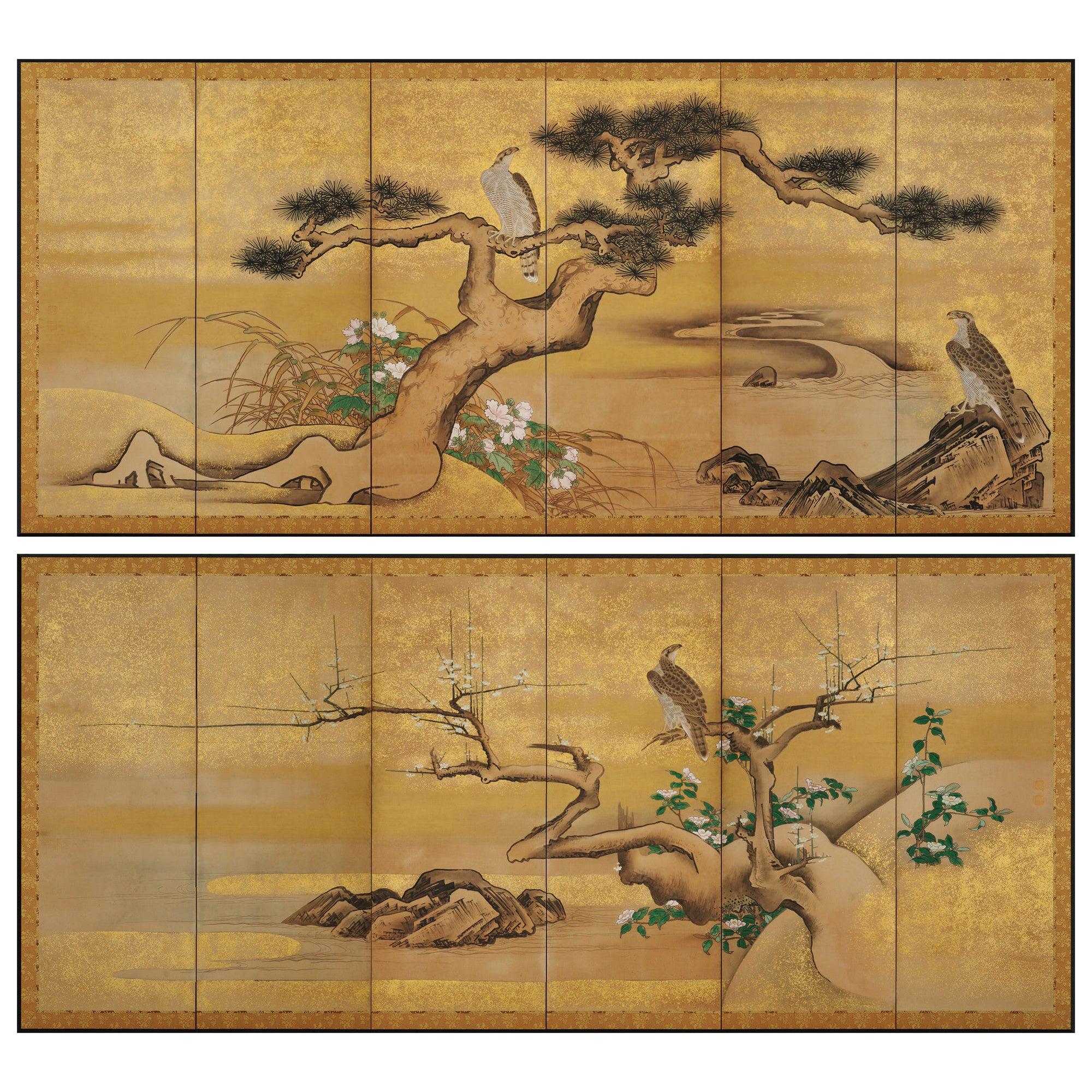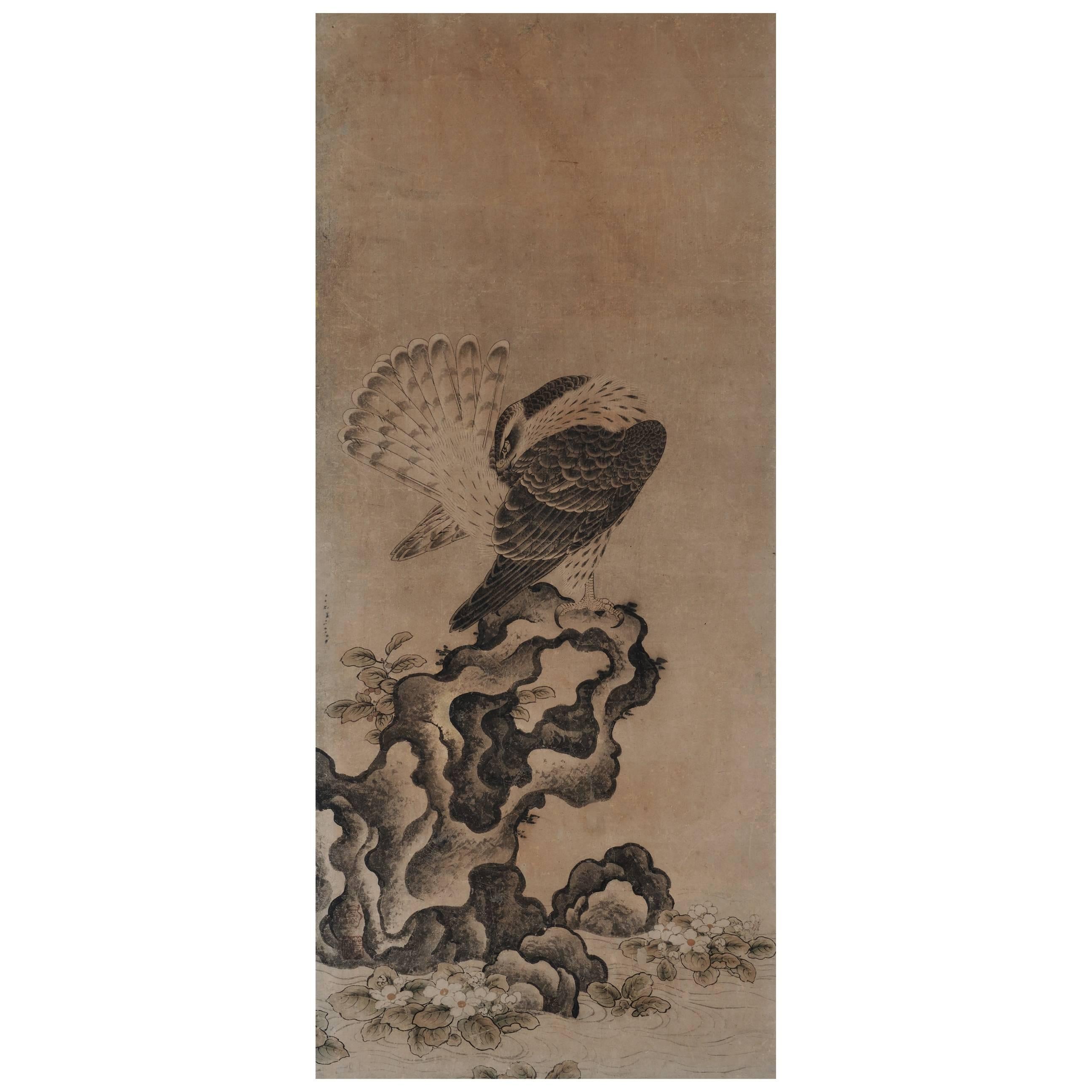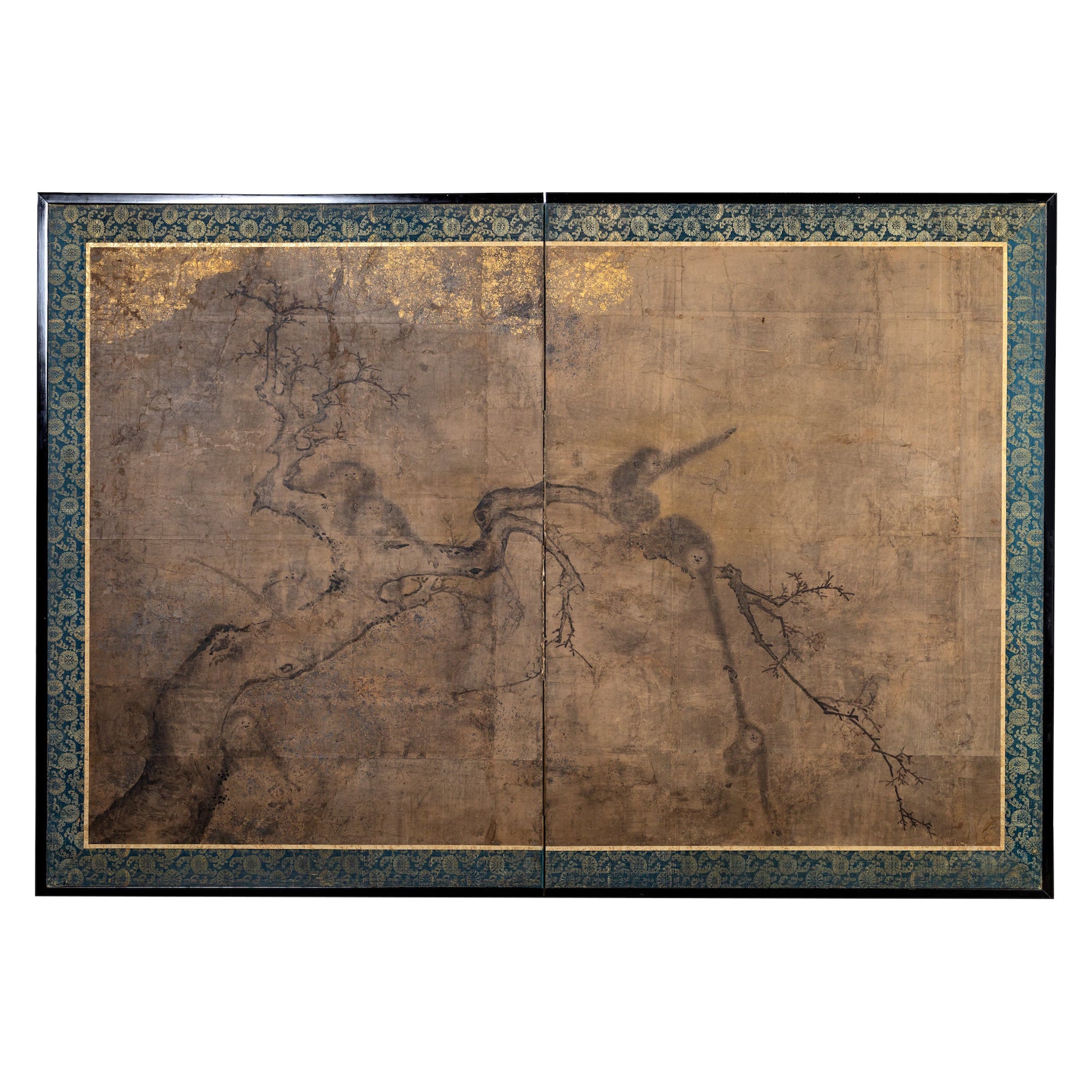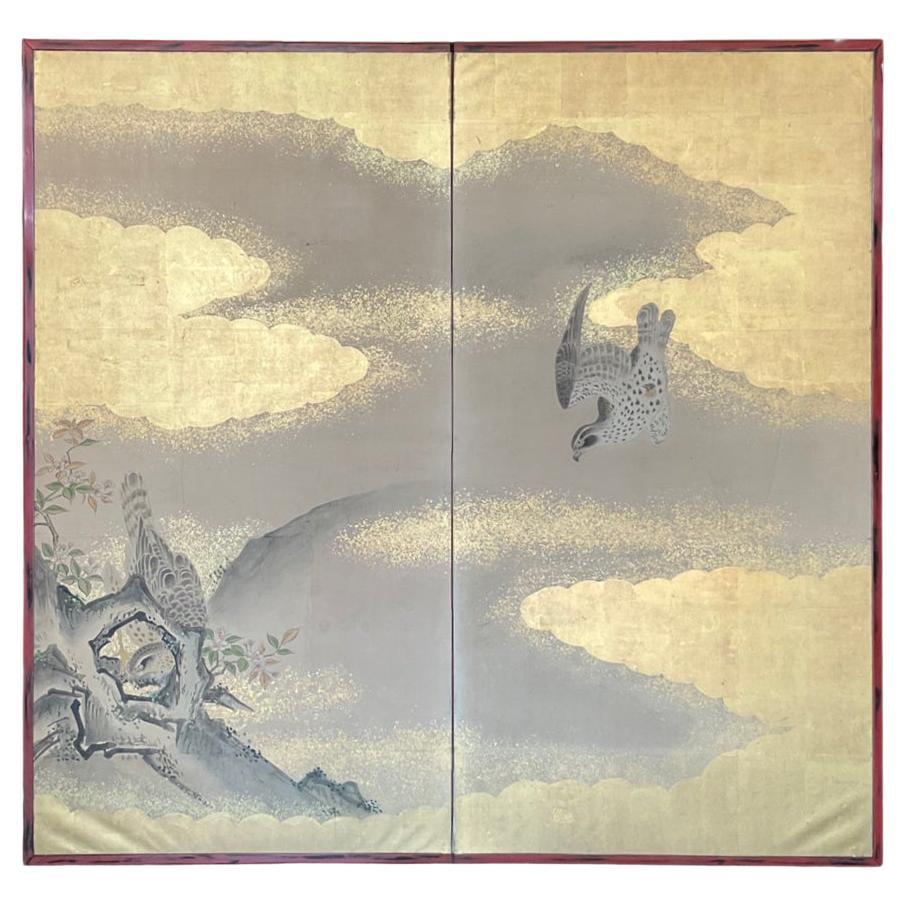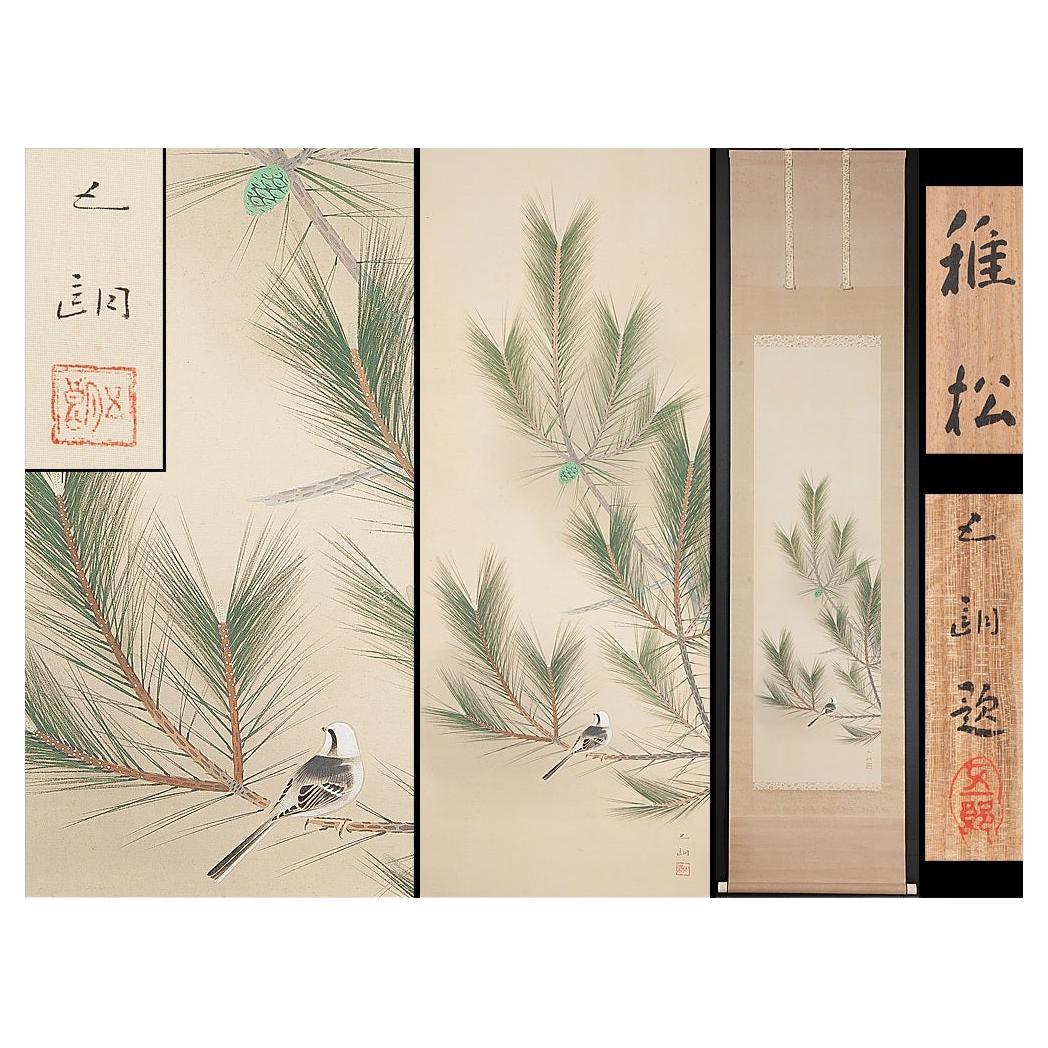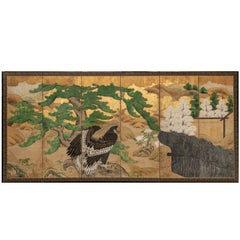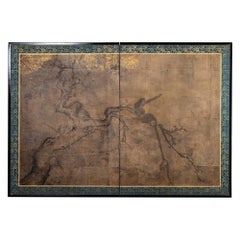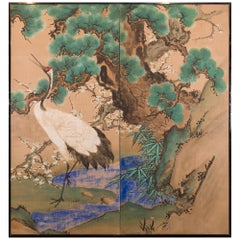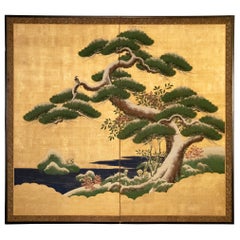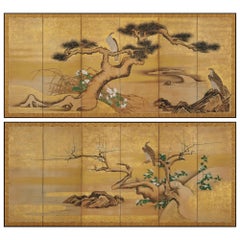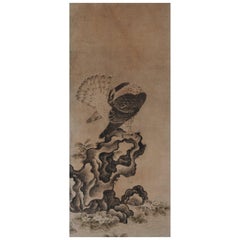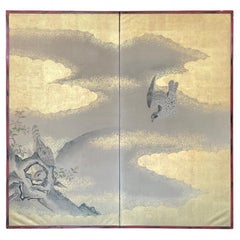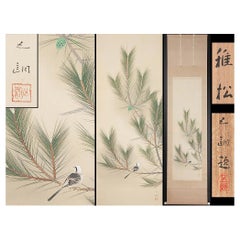Items Similar to Japanese Two Panel Screen: Hawk Perched in Pine Tree
Want more images or videos?
Request additional images or videos from the seller
1 of 9
Japanese Two Panel Screen: Hawk Perched in Pine Tree
$51,750
£39,552.43
€45,587.34
CA$74,115.95
A$81,228.83
CHF 42,419.24
MX$974,652.22
NOK 532,645.99
SEK 501,732.77
DKK 340,421.02
About the Item
Hawks were a popular motif in artwork because Japanese falconry, or takagari, was a sport of aristocrats such as nobles and samurai. Hawks came to symbolize nobility and strength. Suiboku painting (ink on paper in the style of calligraphers), on mulberry paper with silk brocade border.
- Dimensions:Height: 65 in (165.1 cm)Width: 73 in (185.42 cm)Depth: 0.75 in (1.91 cm)
- Materials and Techniques:
- Place of Origin:
- Period:
- Date of Manufacture:c.1600
- Condition:Condition report upon request.
- Seller Location:Hudson, NY
- Reference Number:Seller: S03601stDibs: LU855134325792
About the Seller
5.0
Recognized Seller
These prestigious sellers are industry leaders and represent the highest echelon for item quality and design.
Established in 1971
1stDibs seller since 2008
166 sales on 1stDibs
Typical response time: 8 hours
Associations
The Art and Antique Dealers League of AmericaAntiques Associations Members
- ShippingRetrieving quote...Shipping from: Hudson, NY
- Return Policy
Authenticity Guarantee
In the unlikely event there’s an issue with an item’s authenticity, contact us within 1 year for a full refund. DetailsMoney-Back Guarantee
If your item is not as described, is damaged in transit, or does not arrive, contact us within 7 days for a full refund. Details24-Hour Cancellation
You have a 24-hour grace period in which to reconsider your purchase, with no questions asked.Vetted Professional Sellers
Our world-class sellers must adhere to strict standards for service and quality, maintaining the integrity of our listings.Price-Match Guarantee
If you find that a seller listed the same item for a lower price elsewhere, we’ll match it.Trusted Global Delivery
Our best-in-class carrier network provides specialized shipping options worldwide, including custom delivery.More From This Seller
View AllJapanese Six Panel Screen: Hawk with Ancient Pine Overlooking Twig Fence
Located in Hudson, NY
Beautiful and dramatic Kano school painting of a hawk perched on a rock. With flowering cherry, peonies, pine and bamboo. Twig fence on the right is made of heavily oxidized silver...
Category
Antique 18th Century Japanese Paintings and Screens
Materials
Gold Leaf, Silver Leaf
Japanese Two Panel Screen: Gibbons in a Tree
Located in Hudson, NY
Ink painting on mulberry paper of gibbons in a tree with hints of gold in the sky.
Category
Antique Early 18th Century Japanese Paintings and Screens
Materials
Paper
Japanese Two Panel Screen Manchurian Crane and Turtles
Located in Hudson, NY
In Japan, cranes symbolize fidelity as they mate for life and turtles symbolize longevity. Additionally, this screen also has the Japanese motif of sho-chiku-bai, or the three friends of winter (pine, plum, and bamboo). So called the three friends of winter because all three flourish during the cold months. This screen was originally fusuma doors...
Category
Antique Mid-19th Century Japanese Edo Paintings and Screens
Materials
Paper
Japanese Two Panel Screen: Pine in Snow
Located in Hudson, NY
Kano School, Mineral pigments on gold leaf with silk brocade border and lacquer wood trim.
Category
Antique Mid-19th Century Japanese Paintings and Screens
Materials
Gold Leaf
Japanese Two Panel Screen: Bamboo and Manchurian Crane
Located in Hudson, NY
Kano style painting in mineral pigments on silk with a silk brocade border.
Category
Early 20th Century Japanese Paintings and Screens
Materials
Brocade, Silk
Japanese Six Panel Screen, "Amorous Pheasants in Venerable Garden Pine"
Located in Hudson, NY
In a garden landscape with vibrant red camellias on a natural garden stone sculpture, mineral pigments and silver dust on mulberry paper.
Category
Antique 19th Century Japanese Paintings and Screens
You May Also Like
17th Century Japanese Screen Pair by Soga Nichokuan, Hawks on Pine & Plum Trees
Located in Kyoto, JP
Hawks on plum and pine
Soga Nichokuan (active circa 1625-1660)
Pair of six-fold screens.
Ink, mineral pigments, gofun, gold and speckled gold l...
Category
Antique 1640s Japanese Edo Paintings and Screens
Materials
Wood, Paper
Japanese Painting, Framed Panel, 17th Century Falcon by Mitani Toshuku
By Mitani Toshuku
Located in Kyoto, JP
Mitani Toshuku (1577-1654)
“Falcon”
Wall panel, ink and light color on paper.
Upper seal: Mitani
Lower seal: Toshuku
Dimensions:
Each 118.5 cm x 51 cm x 2 cm (46.5” x 20” x .75”)
Individual falcon paintings by Mitani Toshuku (1577-1654), an early artist of the Unkoku School. Founded by Unkoku Togan (1547–1618), a master of the Momoyama period, the Unkoku school enjoyed long lasting patronage in southern Japan. Togan was a retainer of the Mori family in present day Yamaguchi prefecture. Members of the school considered themselves to be in the artistic lineage of Sesshu Toyo...
Category
Antique Early 17th Century Japanese Edo Paintings and Screens
Materials
Wood, Paper
Majestic Hawks Edo Screen by Tosa School
Located in Fukuoka, JP
Majestic Hawks Edo Screen
Period: Edo
Size: 150x168 cm (59x66 inches)
SKU: PTA93
Step back in time to the Edo period with our superb Tosa school screen d...
Category
Antique 19th Century Edo Paintings and Screens
Materials
Gold Leaf
Japanese Nihonga Painting 20th Showa/Taisho Scroll Pine Tree and Bird
Located in Amsterdam, Noord Holland
Hanging scroll "Wakamatsu" silk version, painted, signed in box
size Axis: Height 208.5cm Width 49.5cm
Drawing: Height 123cm Width 36cm *There may be slight differences in dimension...
Category
20th Century Taisho Paintings
Materials
Silk
$1,698 Sale Price
20% Off
Mid 18th Century Japanese Screen Pair. Crows & Pines by Unkoku Toshuku.
Located in Kyoto, JP
Unkoku Toshuku (1722-1779)
Crows and Pines
A pair of six-panel Japanese Screens. Ink and gold leaf on paper.
Dimensions: Each Screen: H. 170.5 cm x W. 375 cm
Haha-cho or mynah birds, whose forms resemble crows in artwork, were commonly depicted in Japanese art. These types of paintings were originally modeled on paintings attributed to the 13th century Chinese painter Muqi (Mokkei), whose art was enormously influential in Japan. Crows only became a theme among Japanese artists from the later 1500s onward. They likely were inspired by these imported Chinese paintings of myna birds, which are not native to Japan, substituting the native species of crow instead.
The best known early examples of the depiction of Japanese crows are two Momoyama screen...
Category
Antique Mid-18th Century Japanese Edo Paintings and Screens
Materials
Gold Leaf
Japanese Showa Two Panel Screen Pair of Tethered Hawks
Located in Rio Vista, CA
Captivating Japanese Showa period two-panel folding byobu screen featuring a pair of hawks or birds or prey tethered to a wooden perch. The painting has ink and natural colored pigme...
Category
20th Century Japanese Showa Paintings and Screens
Materials
Brass
More Ways To Browse
Japanese Silk Brocade
Painting Antique Pine Furniture
Japanese Painting Tree
17th Century Japanese Paintings
17th Century Japanese Screens
Japanese Screens Pines
Japanese Screen Tree
Japanese Hawks
Antique Falconry
Antique Hawk Painting
Japanese Screen Hawk
Japanese Lacquer Panels
Chinese Carved Screen
Kano School
Byobu Screens
Asian Black Screens
Japanese Folding Screen Screen
Japanese Silk Brocade
